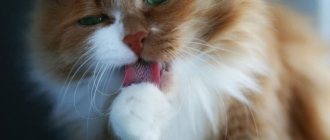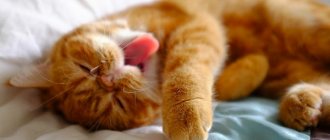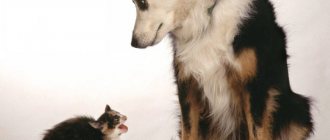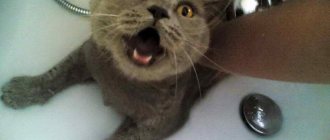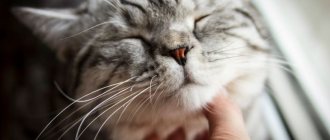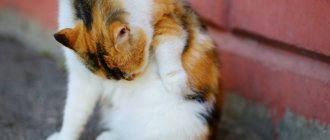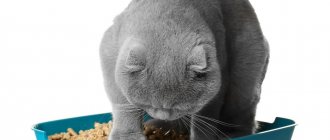Wounds and crusts on a cat’s nose are a consequence of dermatitis, an allergic reaction or an infectious disease. At home, it is impossible to make a diagnosis on your own, since this requires a culture of the flora from the nose and an analysis of scrapings.
The crusts on your cat's nose may be brownish or black. This symptom is characteristic of a fungal infection, an inflammatory process in the nasopharynx, or an allergic reaction. The most harmless cause of crust formation is considered to be household injuries.
The fact is that a healthy cat’s nose is slightly wrinkled. This prevents the normal restoration of damaged skin, so wounds can take a long time to heal. If the owner is absolutely sure of the nature of the crusts, it is necessary to help the pet’s body recover as quickly as possible. To do this, it is recommended to treat your nose with an antiseptic several times a day. Preventing re-infection of the wound significantly accelerates regeneration and the crusts begin to disappear a few days after the start of treatment.
A dark crust on the nose, which is accompanied by discomfort and is a consequence of skin damage, should not be a cause for concern. In this case, no treatment is required; the crust will fall off on its own when the tissues are completely restored.
Treatment with an antiseptic is only necessary if weeping erosions or crusts appear at the site of the wound, blocking the respiratory tract.
Infectious diseases
If a cat has black crusts on his nose that do not heal for a long time, the cause should be sought in infectious diseases. Associated symptoms of infectious diseases:
- Nasal discharge.
- Otitis.
- Lethargy.
- Increased sleepiness.
In this case, the animal may refuse to eat and be lethargic. Particularly severe forms of infectious diseases are accompanied by vomiting and dehydration.
Cat infections are very dangerous, especially if the animal does not have all the necessary vaccinations. Black crusts on the nose are one of the most harmless symptoms; in severe cases, infectious diseases can lead to the death of the pet. You cannot try to cure the cat yourself; you should take the animal to a veterinary clinic. This may require long-term hospital treatment.
Skin and other diseases
The appearance of crusts on the nose often accompanies fungal and bacterial skin lesions. If you suspect a fungus or bacterial infection, you should show the cat to the doctor so that the veterinarian can examine it - make a scraping, conduct a diagnosis using an ultraviolet lamp. Other signs of skin diseases are cracks on the paw pads, ulcerations and scratches on the skin, and areas of split ends and hair falling out.
We suggest you read: Quail eggs why quails don’t lay eggs
Sometimes the appearance of crusts on the nose of cats can be caused by allergies: it can be dried discharge from allergic rhinitis or skin irritation.
If you have a fungal infection, the crusts on your cat's nose may appear black or brown. Fungal diseases should be treated with antifungal agents, such as clotrimazole or fungin.
If a cat has black nasal discharge, this may be a consequence of otitis media or a symptom of a mite or fungus entering the sinuses and developing inflammation. To help your cat, you should get tested (scraping from the affected area) as soon as possible and, depending on the results, select a suitable treatment regimen from your veterinarian.
Black crusts under a cat's nose may be the result of a fungal infection.
Dermatological diseases
Crusts on a cat’s nose can be the result of skin pathologies and dermatitis. These diseases are caused by fungi and bacteria. To accurately determine the cause of the formation of crusts, it is necessary to undergo a series of tests, including a nasal microflora smear and skin scraping from the affected area. The doctor will also illuminate the animal with a special lamp, which allows you to quickly determine the presence of fungal infections.
Treatment depends on the type of disease. For fungal infections of the epidermis, antimycotic drugs are used. Treatment is carried out using ointments and solutions for treating the nose. In case of a bacterial infection, the crusts should be treated with antibacterial drugs, for example, Levomekol ointment.
For dermatological diseases, antiseptic treatment of the affected area is mandatory. This is necessary to prevent secondary infection. For this purpose, a solution of chlorhexidine or miramistin is used.
Causes
But is everything as dangerous as the brain, “inflamed” from thinking, portrays? There is no need to rush to bother the doctor and take extra money to the clinic. First, you should figure out what caused the crusts to appear; to do this, you need to carefully examine your pet’s body. Wounds and scabs in tailed pets can occur as a result of various events. The most common causes of crust formation on a cat's nose are:
- Injury.
- Dermatitis.
- Allergy.
- Infection.
A sore on the tip of a cat’s muzzle can take quite a long time to heal. If the owner is completely confident in the nature of the wound and knows that nothing threatens the pet’s health, he can treat the sore nose himself.
Injury
If the cat slightly hit his nose on some object, and as a result of this a crust formed on the wound, there is no need to worry too much. The sore may occur due to injury during a fight between relatives. Thin, delicate skin is easily injured even during normal home games. The crust may represent clotted blood if the animal has had a nosebleed. Then you should monitor the condition of the fluffy. If his breathing is normal, there are no hematomas in other parts of the body, and the scabs do not become wet, then the danger has passed.
Remember! For speedy healing, it is advisable to treat the scabs with an antiseptic, but only if they begin to fester. If left untreated, the wound may become infected. Then the cat's health may suffer serious consequences.
It is worth paying special attention to the fact that dry black crusts on a cat’s nose do not need to be treated. “Cauterization” requires only weeping erosions that prevent the animal from breathing normally.
Dermatitis
Skin diseases are no less common cause of crust formation than injuries. Dermatitis is formed due to the introduction of fungi or bacteria into the epidermis of an animal. By the way, some of them can be transmitted to humans.
To identify the real pathogen, you should visit the clinic and submit a scraping for laboratory testing. In addition, the veterinarian will send the patient to the treatment room to take a number of other tests to establish the most accurate clinical picture.
A swab will be taken from the cat's nasal passage, which will determine the state of the microflora. The doctor may suggest illuminating the pet with a special lamp - the manipulation allows you to instantly determine the type of fungus. The regimen and duration of treatment depends on the established diagnosis. Fungal spores are destroyed with the help of appropriate medications - ointments, gels, creams.
Antibacterial drugs, for example, Levomekol, will help fight bacterial infection. True, the lesion, as well as the healthy tissue adjacent to it, is first treated with antiseptics. Miramistin and Chlorhexidine are suitable for cleaning. The preparatory procedure is required. After all, secondary infection can significantly worsen the condition of a sick patient.
Allergic reactions
Allergens can appear in a cat’s body in response to external stimuli:
- food products;
- household chemicals;
- flowering plants;
- veterinary drugs;
- toys, interior items made of low-quality materials;
- synthetic bedding;
- harmful emissions, tobacco smoke;
- gas pollution, dust.
The crusts on your cat’s nose will disappear on their own as soon as histamine returns to normal. To reduce the level of the “raging” hormone, you should give the animal a medicine (Suprastin, Tavegil or Diazolin). Additionally, you need to protect your pet from contact with the allergen.
Wounds and allergies
Sores and crusts on a cat's nose and around the lips may be the result of an allergic reaction. Typically, such symptoms appear in response to food allergens, but damage to the skin of the nose can be caused by contact with household chemicals.
For treatment, special antihistamine drops are used. You can buy them at a veterinary pharmacy. If the allergic reaction is moderate, it is enough to eliminate the irritant for the symptoms to subside. No specific treatment is required; it is enough to avoid contact with the allergen in the future and treat the crusts with an antiseptic to prevent infection.
Nose injuries
The crusts on your cat's nose may be brownish or black. This symptom is characteristic of a fungal infection, an inflammatory process in the nasopharynx, or an allergic reaction. The most harmless cause of crust formation is considered to be household injuries.
The fact is that a healthy cat's nose is slightly moist. This prevents the normal restoration of damaged skin, so wounds can take a long time to heal. If the owner is absolutely sure of the nature of the crusts, it is necessary to help the pet’s body recover as quickly as possible. To do this, it is recommended to treat your nose with an antiseptic several times a day. Preventing re-infection of the wound significantly accelerates regeneration and the crusts begin to disappear a few days after the start of treatment.
A dark crust on the nose, which is accompanied by discomfort and is a consequence of skin damage, should not be a cause for concern. In this case, no treatment is required; the crust will fall off on its own when the tissues are completely restored.
Treatment with an antiseptic is only necessary if weeping erosions or crusts appear at the site of the wound, blocking the respiratory tract.
Calcivirosis
If a black crust suddenly appears on your cat’s nose, you should take a close look at the animal’s behavior. One of the dangerous cat diseases is calcivirosis. Animals are usually vaccinated against this disease, but street cats that accidentally enter the house may not be vaccinated. Symptoms of calcivirosis:
- wounds and crusts on the mucous membranes of the mouth, ears and nose;
- conjunctivitis and tearing eyes;
- damage to the paw joints;
- increased body temperature;
- swollen lymph nodes;
- labored breathing.
To treat calcivirosis, you should consult your doctor about the use of medications. There is no universal treatment regimen for this disease; therapy is selected depending on the symptoms and age of the pet.
Crusts on the nose should be lubricated with chlorhexidine or Lugol's solution twice a day. To make breathing easier, the nasal passages must be treated with special drops.
Cat's nose -
an absolutely unique organ.
The structure and shape of a cat's nose
is as individual as a person's fingerprints. It can be used to identify the animal.
Brief structure. Nasal cavity
Lines the mucous membrane, which contains blood vessels and nerves.
It is the first line of defense against foreign bodies and bacteria. Inside the cat's nose there is an epithelium containing receptors
. The nostrils are located in bone and cartilage tissue. They are responsible for heating the air when you inhale and removing moisture from it when you exhale.
cat nose
- a delicate organ by which
one can judge the state of her health
and identify signs of disease.
Healthy cats have
normally cool and damp.
It is moistened by both the secretion secreted by the nasal mucosa and by the tongue when licked. But you can’t judge a cat’s temperature by the moisture in its nose, since its nose
is always
dry and warm
during sleep, in the heat and when excited. In older animals, the nose may constantly be dry and warm due to poor functioning of the gland that produces secretions to moisturize it.
The cat's nose has changed color! What does it mean? Over the course of a day, a cat's nose changes color intensity depending on the cat's activity.
. When a cat sleeps or is inactive, the nose turns pale; when it moves a lot, plays, or has eaten well, the nose becomes brighter. The filling of the blood vessels of the nasal mucosa is responsible for this. During sleep, the heart rate decreases; during intense exercise, on the contrary, blood flow increases.
Some breeds have a specific nose color that matches their coat color, ranging from light pink to black. And it happens that the color of the nose changes and is finally established closer to the age of one year.
There are cases where the color of a cat's nose reacted to changes in hormonal levels. Depigmentation began with the onset of estrus, and after birth the color gradually restored. There is also a phenomenon called “winter nose”
. The cat's nose turns pale in the cold season and darkens in the hot season. Perhaps the body lacks sunshine (vitamin D and other microelements).
Carefully! A white nose can be an alarming symptom!
If your cat's nose discolors from pink to white, this may be a sign of dehydration, even
anemia
(decreased hemoglobin levels in the blood, usually with a decrease in the number of red blood cells).
Anemia itself is not a disease, but it is considered one of the symptoms of various pathologies. In this case, the first thing you need to do is pay attention to your cat’s gums. If instead of a healthy pink color, this is a reason to urgently contact a veterinarian. Anemia can be caused by
an unbalanced diet and lack of microelements, or be a sign of leukemia, a viral disease, pathology of internal organs (for example, renal failure), etc.
If the nose is white
accompanied by other symptoms (diarrhea, apathy, lethargy, loss of appetite and weight) - medical intervention is required immediately! In any case, diagnostics, a complete blood test, and tests for viral diseases are necessary. Treatment is prescribed depending on the established diagnosis.
Cat's nose. What if the cat's nose changed color? was last modified: December 17th, 2014 by allpets1
If the owner notices a black nose on a cat, he should think about the health of his pet. The fact is that an animal that does not have diseases should have a clean and slightly moist nose. Only after sleep does this organ have a higher temperature and is dry. Therefore, any signs of sores, scabs, discharge or even anything that looks like dirt should be a cause for concern.
Why is the nose black
Among all the possible reasons for such a deviation, several main ones can be identified. This:
- injuries;
- infections;
- skin diseases.
Only a professional can determine the exact prerequisites for the appearance of such a symptom. However, for those who prefer home treatment, there are some special signs.
Injuries
The first reason for the formation of a crust on a cat’s nose can be a common injury. The fact is that the coat in this area of the cat is quite thin and delicate. Therefore, getting seriously injured is not that difficult. You should examine your pet, because ordinary dried blood can give a black color. It can be removed with a regular damp cloth or cotton wool. If under the crust the nose is of a normal color, you don’t have to worry about the consequences for the animal.
If the kitten is simply scratched, you should not try to get rid of the rough skin.
It will fall away on its own. Of course, the exception is cases when such a crust blocks the airways. Here you need to help your cat. Of course, only a specialist can provide proper care in this case.
Infections
If a cat has a black spot on its nose, which is accompanied by discharge, we can draw conclusions about the presence of more serious diseases. Here you can suspect rhinoinfection, tracheitis or even calicivirus. In this case, other symptoms will appear. The cat may become more lethargic, lose appetite, and show inactivity.
Among other things, you may notice that the pet began to sneeze frequently and rub its face with its paws. Sometimes the disease appears as white or green purulent discharge from the eyes. If such signs appear, you should immediately contact a veterinary clinic. Only a doctor can diagnose and prescribe the correct treatment.
Skin diseases
If a kitten has black crusts in its nose accompanied by skin lesions near this organ, this indicates the viral nature of the disease. It could be a simple bacterial infection or a fungus. In this case, the clinic must give the cat the necessary tests that will determine what is wrong with the pet.
It is important that such diseases can easily be transmitted to humans. If such symptoms are detected, hygiene procedures should be carried out as carefully as possible and it is advisable to minimize contact with the animal.
Black spots on a cat's nose or other place are always a reason for diagnosis. If this symptom appears on the chin, for example, it may indicate acne. Of course, it is not necessary to rush to the clinic on the same day, but such a serious problem cannot be ignored.
Regardless of whether symptoms other than blackheads or spots appear, it is important to provide your cat with proper care. This will keep your pet healthy. With such care the cat will live for many more years.
Cat owners determine the health status of their mustachioed pet by its nose. This is partly correct. But a dry nose in cats is not always a sign of illness. When should you worry, and when should you just wait until the nose becomes wet without outside help, and why in cats the olfactory organ can be dry, let's look at it.
Reasons for the problem
The appearance of a crust on a kitten’s nose is an alarming sign of the development of very serious problems. Sometimes such a symptom occurs due to basic damage to the nose. Sensitive tissues may have been damaged during a fight or during exploration of the outside world. Sometimes kittens damage their nose by scratching it on the edge of a table or on sharp objects in the house.
Often, a brown crust appears due to bleeding, which the owner may not have noticed. The remaining blood on the nose hardens, turning into a crust. The bleeding itself may indicate the development of very serious diseases related to the functioning of the brain.
However, the most common reason for the appearance of such crusts is infectious diseases. During viral rhinotracheitis, calicivirosis and reaviral infection, liquid is released from the animal’s nose, which hardens in the form of a brown crust. Your kitten's nose may run all the time for several days. The kitten's activity gradually decreases and his appetite completely disappears. Diseases can also lead to death, because the baby’s body is extremely sensitive to a variety of bacteria.
Another common sign of the development of an infectious disease is the animal’s constant sneezing. If a kitten often rubs its nose or snores in its sleep, then most likely it is suffering from a serious infectious disease, which can only be treated under the supervision of a specialist.
Fungal and skin diseases can cause brown crusts to appear on the nose. Typically, fungal diseases are accompanied by cracks on the paw pads, as well as sudden hair loss, so it is quite difficult not to notice the problem.
Nose - features of the organ
The cat's nose is an incredibly complex and reliable tool for exploring the world around us. Newborn kittens, still completely blind and deaf, can rely only on their sense of smell, searching for their mother’s nipples, their brothers and their home by smell.
At a superficial glance, the structure of the cat's olfactory organ can be described as two nasal passages, separated by cartilage (almost like in humans) and leading into recesses, also called ethmoid conchae.
Did you know?
If necessary, the cat can store the scent in the maze to identify the scent that interests her.
If a cat's nose is dirty, its sense of smell is reduced. Therefore, owners must ensure that the nasal passages are not clogged with secretions or debris.
A cat has more olfactory endings than a human. Therefore, her sense of smell is 15 times stronger than ours.
Having smelled the smell of an irritant (chemicals, perfumes, spices, vinegar, citrus fruits), the animal begins to sneeze vigorously, rubs and hides its nose. Moreover, if the smell is barely noticeable to us, then the cat suffers from such aromas. Therefore, you should not scent yourself near your cat or wash your pet’s dishes with cleaning products.
In addition to its olfactory role, a cat's nose also performs other tasks. First of all, animals breathe through their nose. The mucous membranes warm up the inhaled air, and inside it undergoes primary purification from viruses, bacteria and other pathogenic particles.
If a cat has a hot nose, then its thermoregulation function is impaired. Therefore, it is important to control the temperature of your nose. The skin of this organ is highly sensitive to temperature changes, so they can determine the degree of heating of food without even touching it.
The shape of the nose depends on the structure of the cranial bones. The most complete noses are found in breeds with natural proportions.
Important!
Cats with flat faces are prone to various respiratory problems because their nasal cartilage and bones are constricted.
The color of the nose is determined by the color of the cat and often matches the shade of fur on the face, only a couple of shades darker. This is why tricolor cats may have pigment spots on their nose. But if the nose of your adult, but not yet old pet has changed color, then this is a reason to visit the veterinarian.
As cats age, their noses may turn black.
There's nothing wrong with that—as a dog ages, its coat, eyes, and paw pads can change color.
Why do cats have wet noses?
Nasal mucus is a significant feature of this olfactory instrument. A healthy pet has a wet and cool nose, because the nasal pelvis (leathery tip) contains many special glands that secrete fluid. This phlegm coats the sensitive parts of the earlobe in a thin layer, making the nose moist.
The dominant part of the sputum on a cat's lobe is water. With natural evaporation, the surface temperature decreases, causing the lobe to become cool. This layer allows you to distinguish different odors.
When the animal’s body warms up (high temperature, active movements), nasal mucus allows the animal to cool down faster. Thus, nature took care of the health of cats.
Causes of dry nose in cats
By and large, the degree of moisture in the nose directly depends on the animal’s well-being. For example, a warm nose may indicate an increase in temperature. However, there are other reasons for a cat's warm nose.
Normal dry nose occurs in the following situations:
- during sleep;
- upon awakening (first half hour);
- during active games;
- in a room that is too hot;
- with a sharp fright;
- with prolonged exposure to the sun;
- when overeating;
- after childbirth;
- while maintaining a sedentary lifestyle.
Important!
Moreover, if the pet is active and eats with appetite, there is no need to worry.
At the same time, the following signs accompanying dryness indicate that you need to contact a veterinarian:
- the animal is lethargic, apathetic, and feels unwell;
- nose is hot;
- the organ of smell is cold and pale;
- the lobe has changed color (became blue - a sign of poisoning or loss of strength; red, white, became yellow - a symptom of liver failure; turned pale - heart problems);
- rapid or slow breathing (normal: 16-33 breaths per minute) or increased heart rate (normal: 100-120 beats per minute);
- the pet sneezes.
Possible accompanying symptoms when feeling unwell
Be that as it may, a dry and at the same time warm nose can be a sign of a disease that is important not to miss. Therefore, you should not postpone a trip to the veterinarian if other signs are still present:
- dryness is accompanied by the fact that the pet’s ears become hot;
- the animal lost its appetite, lethargy and apathy appeared. In this case, the pet does not react to familiar stimuli, and the temperature has risen to 38.5 °C;
- purulent or mucous discharge from the nose. Typically, such symptoms are accompanied by viral diseases;
- In addition to dryness, the cat exhibits distress and vomiting. Thus, the spout indicates dehydration of the body;
- eyes water, throat dries. A virus may develop or an allergy may occur. Although it may simply be a matter of dry air;
- the cat stopped drinking, her fur became dull and unkempt. This indicates a malfunction of the mucous membranes and dehydration of the body;
- the pet does not make contact, does not eat and sleeps little. This behavior indicates stress;
- increased hyperactivity, the mustachioed pet has become irritable and eats a lot. These signs may indicate neurosis. If the temperature rises to 39.5 °C, you should immediately contact a veterinarian.
Did you know?
Nature has arranged it in such a way that cats with congenital anomalies of the nose or respiratory system die. And the reasons for this are not infections or a virus at all, but ordinary hunger. An animal deprived of its sense of smell is simply unable to track and catch prey.
The main causes of nasal discharge in cats
Many feline diseases cause rhinitis. Infections that enter the animal's body cause an inflammatory process in the mucous membrane of the nasal passages. One of the most common types of discharge is clear discharge from a cat’s nose, which can be a consequence of the following negative factors:
- Hot air. A clear liquid very often appears on the nose of cats during the summer. Dry and hot air provokes wetting of the organ. In this case, no treatment is required. If the owner discovers any additional signs of the pet’s serious condition, it is recommended to consult a specialist. Perhaps the cat has an imbalance of vitamins, or there is a hormonal imbalance. After passing the tests, the veterinarian will draw conclusions and recommend adjusting the diet, or prescribing a course of vitamins and hormonal drugs;
- The presence of foreign irritants in the air. These include plant pollen, smoke, and dust. Cats, like people, can have an allergic reaction to flowering plants, both at home and outdoors. Owners often notice that cats sneeze, snot and tears come out. These are clear signs of an allergy to plants, dust, or smoke floating in the air. To alleviate the animal’s condition, it is recommended to give the pet anti-allergy medications prescribed by a veterinarian, as well as remove allergy-provoking substances from the room, carry out wet cleaning and ventilate the room;
- Virus. In severe cases, the owner of the four-legged dog observes purulent discharge from the cat’s nose. This is a clear sign of an infection or virus that has entered the organ cavity. In this case, antiviral drugs are required. When the body is severely damaged, the pet becomes lethargic, its body temperature rises, it refuses to eat, it sneezes, and it coughs. In this condition, it is necessary to begin antibiotic therapy.
Treatment of mucous and transparent discharged masses and the nasal cavity in cats is carried out only after an accurate determination of the cause of the phenomenon. To alleviate the pet's condition and reduce irritation of the skin of the nose, it is recommended to lubricate the surface with an emollient ointment, such as Oxolinic or Tetracycline. To reduce fever in very furry pets, it is recommended to cut off a few centimeters of fur. If the doctor has determined the presence of serous rhinitis, in which purulent discharge is observed, then nasal drops, such as Anandin, Fosprenil, are prescribed. In case of an allergic reaction, the cat is prescribed antihistamines to block it. One of the most effective is Diphenhydramine in the amount of half a tablet per day for three days. If treatment at home does not give positive results, then you need to show your pet to a specialist and undergo diagnostics.
What should the owner do?
What should the owner do if he suspects his pet is unwell, but it is impossible to immediately take the mustachioed animal to the clinic? First of all, do not panic and observe the condition of your pet.
First aid at home
Of course, it is better to call the veterinarian and tell him about the situation. If the doctor does not see anything critical in the animal’s condition, several recommendations can be followed.
If you suspect your cat is not feeling well, you should measure its temperature.
The norm for a mustachioed pet is 37-38 °C. And don’t panic; it’s better to observe the animal’s behavior throughout the day. Since the vital functions of the body are ensured by many systems, if one of them fails, the entire body suffers.
At the same time, if nasal dryness occurs due to physiological factors, treatment will not be needed. The main thing is that the pet always has access to water.
If the room is too dry and hot, you should ventilate it more often and do wet cleaning.
Diagnostics
If the temperature rises to 39.5 °C, go to the doctor immediately.
In this case, you cannot treat alone, much less give the animal antipyretic drugs intended for humans. It is quite easy for a layman to make a mistake with the dosage, but exceeding the dose, on the contrary, will harm the pet.
Important!
It is almost impossible to make a diagnosis on your own, since most of the symptoms are similar.
An animal, suffering from pain, may meow pitifully, but it is not able to say what is bothering it. Only an experienced veterinarian can guess what the cause of the disease is and carry out the necessary studies and tests. That is why it is necessary to consult a doctor to prescribe adequate treatment.
As you can see, there are many reasons why a cat’s nose dries out and becomes warm. And this is not always a sign of disease. If the pet feels great and its behavior does not cause suspicion, then you can simply wait a while and the nose will become wet and cool again. However, any accompanying sign of an abnormality in the animal’s behavior is a clear reason to visit the veterinary clinic.
The cat's nose is a fantastically complex and precise tool for studying the world around us. Clever kittens, still deaf and completely blind, rely only on their sense of smell, finding milk nipples, the warm side of their mother, littermates and their den by smell. By the nose, the owner determines whether the pet is sick: a dry cat’s nose means it’s hot, a hot nose means the temperature is elevated, a swollen and clogged nose means an infection is suspected.
The structure of a cat's nose in a simplified version is two nasal passages (the two nostrils are separated by cartilage, like in humans), leading into a labyrinth of so-called lattice “shells”. A cat, if necessary, can retain a certain aroma in the “nooks and crannies” of the winding labyrinth, getting rid of impurities in order to more accurately identify the smell that interests it. A dirty nose in a cat means a decreased sense of smell, so it is important to ensure that the nasal passages are not clogged with secretions or debris.
After passing through the labyrinth, the molecules irritate odor-sensitive cells that are connected to the olfactory center of the brain, where aroma recognition occurs. There are many more receptors in a cat’s nose than in a human’s nose – a cat’s sense of smell is 15 times better than ours! The cat hides its nose, rubs it and begins to sneeze uncontrollably, sensing the smell of an irritating substance - chemicals, perfumes, spices, citrus fruits, vinegar. The aroma may seem barely noticeable to us, but the cat physically suffers from such amber, so you should not use perfume near the cat or wash your pet's feeder with cleaning products.
In addition to its olfactory function, the nose performs many other tasks. Cats breathe through their nose, the mucous membranes of the nasal passages warm the inhaled air, and inside the nose the air is pre-cleaned from the smallest particles, viruses, and bacteria. When a cat has a hot nose, the thermoregulation function suffers - it is important to pay attention to the temperature of the nose. The skin of the nose is highly sensitive to temperature changes, so cats can determine the temperature of food or surfaces without even touching the object of interest.
The shape of the nose is determined by the structure of the cranial bones and cartilage. The healthiest noses are those of breeds with “natural” proportions. Cats with flattened faces are susceptible to various respiratory diseases because their nasal cartilage and bones are twisted and compressed.
The color of the nose mirror depends on the color and often repeats the color of the fur on the muzzle, but several shades darker. Pigment spots on the nose in tricolor cats and older pets are a common occurrence. But if the nose of an adult cat suddenly changes color, it is advisable to contact a veterinarian. But don’t panic if your cat’s nose turns black with age—over time, the fur, paw pads, eyes, and nose change color. The tendency to change their “image” is especially noticeable among color-point cats (mask, socks, dark ears, dark tail on a light background). Sometimes the fact that a “point” cat’s nose has turned black is explained by cold weather: the cooler the room, the darker the color, including the nose. For light-colored pets, the opposite is true: in winter the nose is pale, and in summer, under the influence of sunlight, the color becomes richer and brighter.
If a cat has a white nose, the change in its shade can indicate the functioning of the circulatory system, since the shade of blood is clearly visible through the skin, which is devoid of pigment. For example, a bluish color may be a sign of heart disease or lack of oxygen. Reddish, inflamed nasal mucous membranes may be due to infection or mechanical irritation. When a cat has a red nose, high blood pressure is suspected. A yellowish tint to the nose is a sign of liver and kidney disease. In cats whose noses are dark in color, such changes are more difficult to notice. In order not to miss the onset of the disease, instead of the nose, the mucous membranes of the lips and eyelids are examined.
